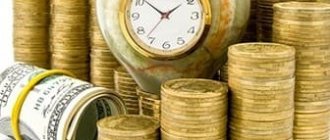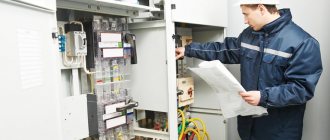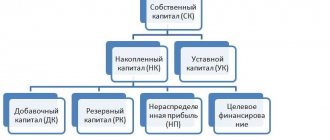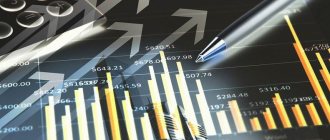What is investment in fixed capital
Investments in fixed capital are understood (section II of Rosstat order No. 746 dated November 25, 2016):
- costs of creation, reconstruction (modernization) of facilities, purchase of machinery, equipment, inventory, classified from an accounting point of view as non-current assets;
- investments in intellectual property;
- investments in biological resources.
Investments in fixed capital can be made both at the expense of one’s own funds and at the expense of borrowed (or received as assistance) funds, within the framework of exchange agreements and equity participation agreements.
Investments in fixed capital do not include the cost of acquiring assets whose price is less than 40,000 rubles, except for cases when these assets are reflected in accounting as fixed assets.
The following are not recognized as investments in the fixed capital of an organization:
- purchase of fixed assets that were previously on the balance sheet of third-party organizations;
- costs of purchasing apartments in multi-apartment residential buildings;
- purchase of land plots, environmental management facilities;
- concluding lease agreements, purchasing licenses, purchasing goodwill, marketing connections (related to non-produced assets in accordance with the system of national accounts).
A synonym for the concept of “investment in fixed capital” is “capital investments” (Article 1 of the Law “On Investment Activities” dated February 25, 1999 No. 39-FZ).
It should be noted that investments in fixed assets (as opposed to, in fact, fixed capital) are outside the jurisdiction of the main sources of law governing the accounting of fixed assets - Order of the Ministry of Finance dated October 13, 2003 No. 91n, as well as PBU 6/01. What rules of law should be considered as guiding principles when accounting for capital investments?
Accounting for investments in fixed assets: basic regulatory standards
The legislator's main attention is paid to accounting for the results of investments - directly the fixed capital listed on the organization's balance sheet. As soon as fixed capital is formed and reflected in accounting at its original cost, it already falls under the jurisdiction of the specified rules of law - order No. 91n and PBU 6/01.
Until the moment an object of fixed assets is registered, an accountant can legally be guided by only one source of law - Order of the Ministry of Finance of the Russian Federation dated October 31, 2000 No. 94n, which introduces charts of accounts used by private enterprises.
Adjustments
In most cases, the approaches mentioned above provide an accurate estimate of the amount of capital invested, but in some cases additional adjustments must be made to compensate for misstatements in the financial statements.
Off-balance sheet reserves
The amount of invested capital must be increased by the amount of such reserves. For example, a reserve for doubtful debts does not mean that the company will not necessarily receive this money.
How to account for investments in fixed capital according to Order No. 94n (on accounting accounts)
The order in question introduces account 08 “Investments in non-current assets”, which can be legally used to reflect investments on the balance sheet of an enterprise as accounting objects. But as soon as the result of these investments is the manufacture or acquisition of a fixed asset, its accounting is kept in another account - 01 “Fixed Assets”, and this accounting is regulated, as we noted above, by the norms of Order No. 91n and PBU 6/01.
Account 08 “Investments in non-current assets” can reflect costs incurred from any sources of financing:
- own;
- borrowed;
- allocated from the budget.
Account 08 reflects the costs of creating, modernizing, as well as maintaining the enterprise’s capacities, purchasing equipment, machinery and other production and non-production fixed assets.
This is evidenced by the provisions of clause 1.2.1 of the Recommendations for accounting in agricultural cooperatives, approved by the Ministry of Agriculture of Russia on January 25, 2001. Based on the principle of legal analogy, due to the absence of other industry norms, this formulation can also be applied to enterprises in other areas not related to agriculture.
An enterprise, when accounting for investments in fixed assets, can open various sub-accounts to account 08 if necessary. For example, if capital investments are made in the independent production of an asset, then subaccount 08.03 “Construction of fixed assets” can be used. If an asset is purchased, subaccount 08.04 “Purchase of fixed assets” is used.
Account 08 of the Chart of Accounts is rightfully classified as active. That is, its debit reflects directly investments in working capital, and its credit reflects the write-off of the enterprise’s costs in the process of capitalizing certain assets. The entries in this account reflect the monetary value of business transactions on an accrual basis from the beginning of the reporting year.
In what cases are investments in non-current assets subject to property tax, ConsultantPlus experts explained. Get trial access to the K+ system and go to the Tax Guide for free.
Let us now study the nuances of accounting for investments in fixed assets using the specified account and its subaccounts in more detail.
Investments in OS can be made in the form of:
- investments in independent production of funds;
- investments in the production of funds using contractors;
- purchases of ready-made funds.
Example of calculating invested capital
Let's consider the algorithm for calculating the amount of invested capital and its indicators using the example of the balance sheet of enterprise X:
| Assets (thousand cu) | Liabilities (thousand cu) | ||
| Current assets | Current responsibility | ||
| Cash | 2200 | Short-term loans | 5630 |
| Accounts receivable | 4840 | Accounts payable | 6680 |
| Reserves | 8650 | Accrued liabilities | 2890 |
| Other current assets | 1410 | Advances received | 1770 |
| Total current assets | 17 100 | Income tax liabilities | 1230 |
| Total current liabilities | 18 200 | ||
| Long-term assets | long term duties | ||
| Fixed assets | 27 250 | Long-term loans | 8500 |
| Goodwill | 8100 | Deferred tax liabilities | 40 |
| Other long-term assets | 4540 | Other long-term liabilities | 1050 |
| Total non-current assets | 39 850 | Total long-term liabilities | 9550 |
| Total assets | 56 990 | Equity | |
| Preferred share capital | 22 570 | ||
| retained earnings | 6630 | ||
| Total equity | 29 200 | ||
| Total liabilities | 56 990 |
The initial amount of invested capital is equal to the amount of current assets –
17,100 thousand. e.
Planned expenses for operating equipment rental for the next 5 years:
- 3350 thousand;
- 3550 thousand;
- 3600 thousand;
- 3800 thousand;
- 3750 thousand
Weighted average cost of capital - the minimum return at which the costs of searching for investors, etc. (raising funds) will be compensated - 15%.
- Add off-balance sheet assets (operating leases) adjusted for weighted average cost of capital = (3350/1.15) + (3550/1.152) + (3600/1.53) + (3800/1.54) + (3750/1.55) ) = 12,000 (thousand cu).
- Add the amount of long-term assets = 39,850 thousand.
- Subtract current non-interest circumstances (accounts payable, accrued debt, advances, income tax debt) = 6680 + 2890 + 1770 + 1230 = 12,570 (thousand cu).
- Subtract deferred tax liabilities = 40 thousand. e.
We take these adjustments into account and calculate the final amount of invested capital = 17,100 + 12,000 + 39,850 - 12,570 - 40 = 56,340 (thousand cu).
Accounting for capital investments on account 08: OS production
Accounting for funds produced by an enterprise independently in an economic way is carried out during the following business transactions:
1. Payment of wages to employees involved in the production of fixed assets. This payment is made by posting:
Dt 08.03 Kt 70 - the accrual of the actual salary is reflected;
Dt 08.03 Kt 69.01 (02, 03, 04) - the accrual of contributions to the Pension Fund of the Russian Federation, the Social Insurance Fund, and the Federal Compulsory Medical Insurance Fund is reflected on wages.
2. Acceptance of equipment into the production workshop for the purpose of installing it on the fixed asset facility being created. This operation is reflected in the register using the following entries:
Dt 08.03 Ct 07.
3. Acceptance of materials into the production workshop for the purpose of their use in the creation of fixed assets. The following correspondence applies here:
Dt 08.03 Kt 10.
4. Implementation of other expenses not classified within the above operations, but directly related to the creation of an item of fixed assets, which characterize the corresponding operations. For example, these may be costs associated with paying for the services of transport companies. They are reflected in the registers by posting:
Dt 03/08 Kt 60.
Thus, the main accounting objects within the framework of investing in fixed assets will be:
- expenses for labor, equipment, materials;
- expenses for third party services.
In turn, if an enterprise, investing in the production of fixed assets, attracts contractors, then the cost of work performed by these contractors (excluding VAT) is reflected in the debit of account 08 and the credit of account 60. VAT is reflected in the debit of account 19.01.
Another way to invest in OS is to purchase ready-made assets.
What it is
Invested capital refers to those funds that have been invested in the enterprise throughout its existence.
This includes both funds from owners and investors, as well as credit. Why define it? To evaluate the effectiveness of business activities using indicators such as free cash flow, return on invested capital, economic value added.
Who can invest funds
The source of invested capital for the operation of the enterprise can be:
- individual;
- entity;
- state.
They can be the founders of the project, act as lenders or investors. Investments involve the investment of funds or material assets in the development of an enterprise with the aim of generating profit in the future.
Areas of activity for investment
If you have free funds that you want to invest somewhere, you should pay attention to investment methods that can give a positive result:
- investing capital in your own business. The method is not for lovers of passive income, but rather for those who want not only to benefit, but also to work hard on creating and promoting a business. But there is one significant advantage: you do not need to share profits with other investors, because the enterprise is completely yours;
- purchasing a franchise – the right to open a business with a ready-made brand. Advantages: no need to spend money on advertising; franchise owners help in opening a business and its further management; the invested funds quickly pay for themselves, because you acquire a known successful enterprise model with a ready-made name and reputation. The downside is the lack of opportunity to create something according to your vision; you cannot make changes to the brand;
- investing in startup development. Investors of new developments, as a rule, receive about 80% of the profit, since the startupers themselves rarely have their own invested capital to implement the idea. If you choose the right project, the invested capital will quickly pay off and bring considerable profit. But a startup can also bankrupt the investor;
- capital invested in shares of a company. A share is a security that gives the right to own a certain share of a company. The owner of the shares will receive a profit equivalent to the percentage of shares he owns. Before purchasing securities on the stock exchange, you need to study the financial activities of the enterprise. Otherwise, there is a risk of buying shares of an unprofitable company and receiving a percentage of zero profit;
- purchase of bonds. Capital invested in bonds can be considered funds lent to an enterprise. It, in turn, gives you a security - a bond. According to it, the company undertakes to pay you a certain amount;
- investing in production work. You can't go wrong by choosing to invest in a plant that produces well-known mass-produced goods;
- capital invested in small businesses. It will pay off only if you choose the investment object wisely;
- purchasing a share in an investment fund (UIF). A mutual fund is an organization to which you provide your capital, and it already manages its investment.
Forms of investment
Forms of investment are methods of selling available funds. These methods can be used by both an entrepreneur (individual) and a legal entity.
Depending on the investment object, the following forms of investment are distinguished:
- purchase of securities (shares, bonds) – financial investments;
- use of monetary instruments (bank deposit, etc.). Allows you to preserve invested capital, but will not help to significantly increase it;
- direct investment - investing in production activities;
- investments in authorized capital (technical equipment of production, infrastructure development, etc.).
Risks
Capital invested in various types of enterprises cannot be considered protected. Investing money always involves risks. This is important to remember when choosing an area and a specific investment object.
Types of investment risks:
- direct losses – the risk of losing invested funds;
- indirect losses - they are characterized by the safety of invested funds, but at the same time they depreciate (when purchasing currencies or gold bars);
- loss of profitability - invested funds are saved, but do not bring profit;
- lost profit - failure to receive the amount of profit that could be received.
Diversification helps to significantly reduce these risks - distributing available funds into different areas of business. If we are talking about purchasing securities, buy shares of several companies.
So, if one of them is unprofitable, then the profit from the others will compensate for this problem. Using the same principle, it is recommended to invest in other areas of business.
Formula
To make a decision on investment, it is necessary to analyze several indicators:
- the amount of funds required for investment = one-time investments + ongoing expenses (for rent, salaries, etc.);
- return on investment = expected profit/amount of investment; if the indicator is more than 1, the investment is profitable, if less - not;
- net investment = invested capital - amount of capital depreciation; a good value will be positive – with a + sign.
Such an analysis will help you decide whether it’s worth investing in this project or whether it’s better to find another one.
Accounting for capital investments: purchasing OS
Business transactions that characterize this option for investing in fixed assets are reflected on almost the same principle as in the case of registration of transactions involving the services of contractors during the construction of fixed assets. That is, provided:
- reflecting expenses for the purchase of fixed assets in the debit of account 08 and the credit of account 60;
- when accounting for VAT on the debit of account 19.01.
In addition, if additional spare parts and tools are supplied to fixed assets, their cost can be reflected in the debit of account 10.05. If necessary, other subaccounts of account 10 can be used. For example, subaccount 10.03, if gasoline is supplied along with the fixed asset represented by a car. Or - subaccount 10.09, if the main asset, for example represented by a tractor, is also supplied with agricultural implements (mowers, winnowers).
Fixed assets are accepted for operation at the generated initial cost, and the corresponding business transaction is reflected by posting Dt 01 KT 08. After this, the enterprise accounts for the fixed asset accepted on the balance sheet according to the standards established by the above federal regulations.
You can learn more about the features of accounting using postings to account 08 in the article “08 accounting account (nuances)” .
Results
Investing in fixed assets (making capital investments) refers to the process in which an enterprise invests capital in the creation, modernization or purchase of fixed assets. Before this object is accepted on the balance sheet, account 08 is used to account for investment in it. Afterwards, accounting for the fixed assets object is carried out using account 01 (in accordance with the norms of PBU 06/01 and corresponding sources of law).
You can get acquainted with other facts about the capital investments of the enterprise in the articles:
- “Capital investments in accounting are...”;
- “Formula for calculating specific capital investments (nuances)”.
You can find more complete information on the topic in ConsultantPlus. Free trial access to the system for 2 days.
Definition
Invested Capital
) is the total amount of money invested in the company since the beginning of its activities.
In other words, it is the capital provided by all investors, both the owners of the business and its creditors. This indicator is one of the central indicators in value-oriented management, and is also used in calculating such performance indicators as return on invested capital (ROIC
), Economic Value Added (
EVA
) and free cash flow (
eng. Free Cash Flow, FCF
).






